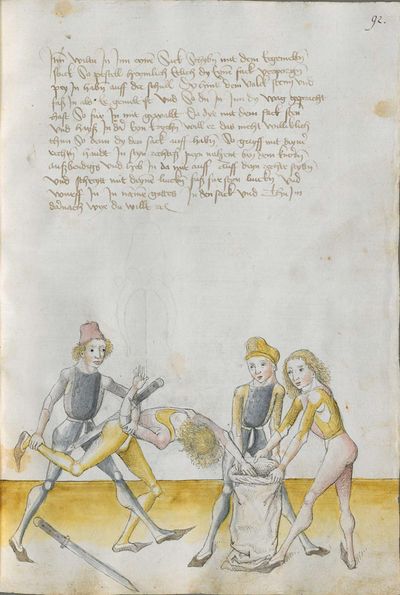One of the things that comes up as an issue with both computer and tabletop RPG’s is the level of violence and the assumptions that go with that. A certain very large RPG company states that a “standard game session” (whatever that means), should consist of about 5 combat encounters, balanced to the players ability levels. There are a number of problems with this but today I want to focus on one in particular – the tendency of players to fight to the death, and to exterminate their opponents.
This can be an issue for two reasons. For one, it’s kind of an ethical issue, if you are simulating the repeated execution of everyone you get into conflict with, it’s a little psycho after a while. Of course for standard Fantasy RPG games, the assumption is that opponents faced by player characters are usually monsters who are categorized as evil, so the grisly chain of slaughtered and dismembered orcs, bugbears, and gelatinous cubes left in the wake of the party is morally defensible.
Without delving into the ethics of killing monsters, (something explored in amusing ways by the Witcher among other literary sources) in a more Low Magic or Historical type setting it’s a bit more of a problem because the opponents are more often people. Some people are villains to an extent that death is the only answer. Others might be in more of a gray area, and there can be strong disincentives to killing everybody you get into a scrap with.
The other major problem with this Conquer or Perish mentality, is that it puts the players themselves at higher risk. This is an particularly important game balance issue with systems like Codex Martialis where combat is much more lethal. Some systems, including many currently active incarnations of DnD, have a built in expectation of player invulnerability. I was recently told by a bunch of people on a major RPG forum (where I originally wrote some of what you are going to read below) that a 1% chance of dying per encounter was too much.
If you are playing with the Codex system, the chance of dying in a relatively even fight is likely to be considerably higher than 1%, and the chance of losing a fight is higher still. The distinction between losing a fight and dying is important, and the difference for the losing party is basically split between 1) running away and 2) surrendering. Similarly, if they win a fight, players have the option of killing, capturing, or driving away their opponents.
Guidelines from history
The hardcore attitude that many modern gamers have inherited from video games and tabletop RPGs alike, of Conquer or Perish, does have it’s historical antescedants. Samurai warriors were not fond of surrendering in combat and didn’t always take prisoners. But in the medieval European world which is the de-facto setting (however many times removed) for a lot of Fantasy genre’s, we do have some examples of a somewhat less ‘hard core’ approach to fighting.
Historically (for example in the middle ages) it was very common for people to be captured rather than killed. There are many techniques for subduing or capturing in the old fencing manuals. Kidnapping was a kind of an industry in parts of Europe back then, particularly among the so-called “Robber Knights” or Raubritter. It was also very common on the battlefields for prisoners to be captured and then either held for ransom or just released. There were many reasons to spare captives, though it was probably rarer in the West than in Central Europe or Italy.
In the autonomous towns it was also very common for people to fight with the flats of their swords and try to fight to subdue an opponent, or just fend them off long enough for the Town Watch to get there or for fellow citizens to intervene. According to the German town laws for example, you were allowed to have disputes, even fights if under sufficient provocation, which could lead to a fine, but if you continued to fight after someone called for “Peace!” then you would get in a lot more trouble, such as exile or even corporeal punishment.
This was sometimes a subject of coarse humor in the fencing manuals. For example this is from the 15th Century treatise on messser (long-knife) fencing from Johannes Lecküchner. Here he has subdued a guy and is playing backgammon

And here is another one where he got his opponent in an arm-lock and they are about to stuff him into a sack

This is a technique from a 16th Century fencing manual from another Fencing Master named Joachim Meyer, where he is hitting his opponent with the flat of his sword on their ear. This would be done in sport fencing (with blunt swords) but also in a real fight, such as if someone was drunkenly antagonizing you and you wanted to get their attention so they would stop.

The master describes it in the following manner:
“… if your opponent cuts at you from above, then intercept him with a Thwart. As soon as it clashes, pull the sword around your head and strike from your left with the outside flat at his ear, as shown by the large figure on the right in Image K, so that the sword rebounds back away. Pull it back around your head in the impetus of the rebound; cut with the Thwart to his left ear; thus it is done.”
In Medieval Europe while brawls, highway robbery and kidnapping for ransom were all commonplace, killing people in a robbery, during petty disputes or due to feuds was much more rare. The reason was twofold with both a carrot and stick incentive.
On the carrot side, ransom was lucrative. You might be able to get a year or more income from ransoming a knight or a merchant. Even petty ransoms were a way to make money – during the 100 Years War between the English and the French, common soldiers started ransoming each other for small amounts of cash. Another issue was that today’s enemy could often be tomorrow’s ally. When Poland defeated the Teutonic Knights at the Battle of Grunwald in 1410, they captured 15,000 German soldiers and mercenaries. The Polish king ended up paroling (unconditionally releasing) 14,000 of them and holding the rest for ransom. He knew that he would need them as allies in upcoming battles with the Mongols and the Russians.
On the stick side, killing or even maiming captives could lead to long term negative consequences. First you could become the subject of a vendetta from their family, as you can see so often in Italy. Second, authorities would escalate their sanctions against you if and when you were caught, and increase their efforts to catch you. Free Cities used to have special “Feud books” where they would enter the names of people who had committed serious crimes against their citizens. Medieval Nuremberg retained a company of men their rivals called Hetzrüden (staghounds) who they would send out to settle scores. They would also post bounties on people. In extreme cases, such as in 1523 when some Robber knights started cutting off the hands of captured merchants and sending them to their families to encourage swifter payment of ransoms, they would go to war. That ‘hand cutting’ was enough for Nuremberg to invoke her alliance with the Swabian league, and send out their militia to burn the castles of some 32 Raubritter, or robber knights, whose names were written in their Feud book.

They helpfully brought a painter along named Hans Wandereisen who acted as a sort of ‘war correspondent’ who painted the scenes at each of these castle burnings. This is one of them, that is Nuremberg militia on the bottom left with the striped red and white flag. You can see all the others here if you are curious.

Capture scenarios are often great adventure hooks. Even when the situation is dire, crazy things could and did happen. This guy is an infamous 14th Century Robber knight called Eppelein von Gallingen. He killed some captives and his name and coat of arms was put into the Nuremberg feud book, which you can see here, and they put out a wanted poster of him which you can see here. He was eventually captured by the city of Nuremberg. They were about to hang him up in the town citadel, when he convinced them to let him sit on his horse one last time. They allowed it, since his hands were tied and he was up in the castle, but he spurred the horse and jumped over the wall and into the moat, then managing to escape. The exploit was so famous that even in Nuremberg there were murals of the guy and songs about him were sung. They did get him about ten years later but he had a pretty good run..
If you’re looking to add more realism and historical accuracy, or to your d20 RPG — or you just can’t get enough of the violent creativity of the middle ages, check out Codex Martialis.

